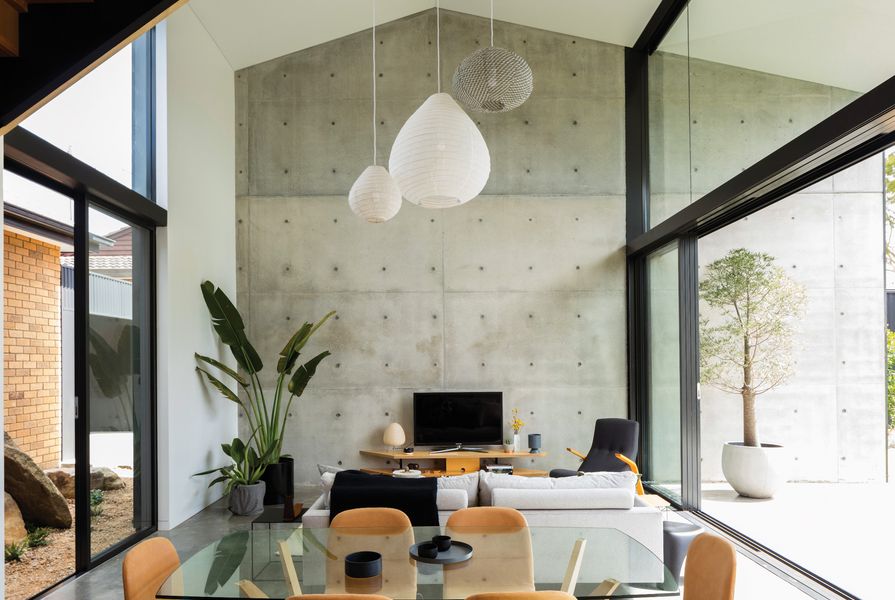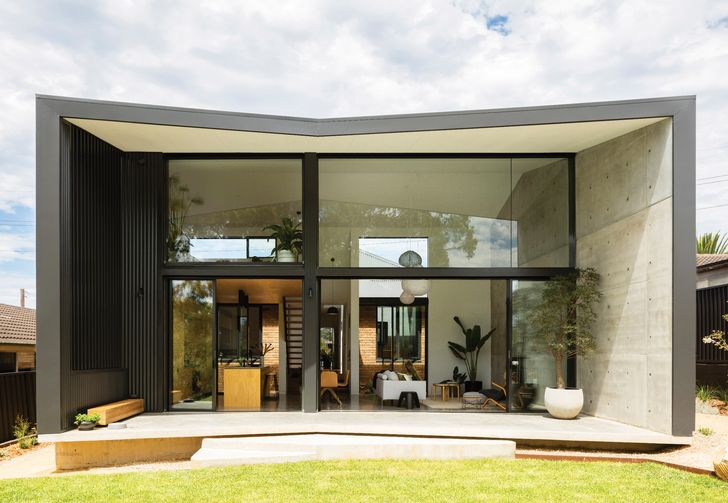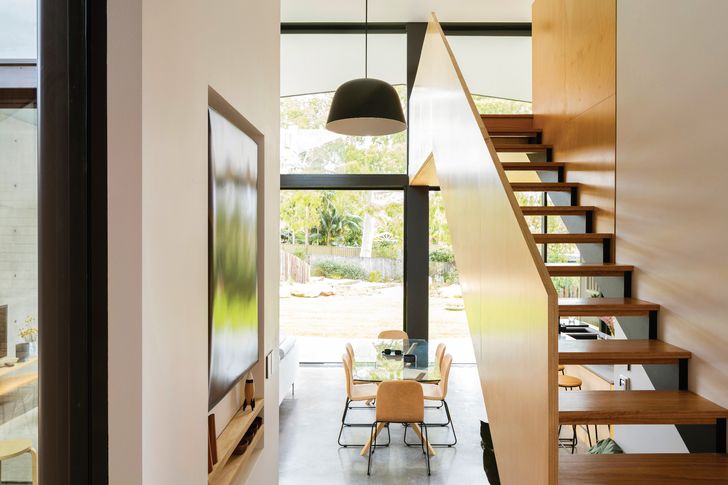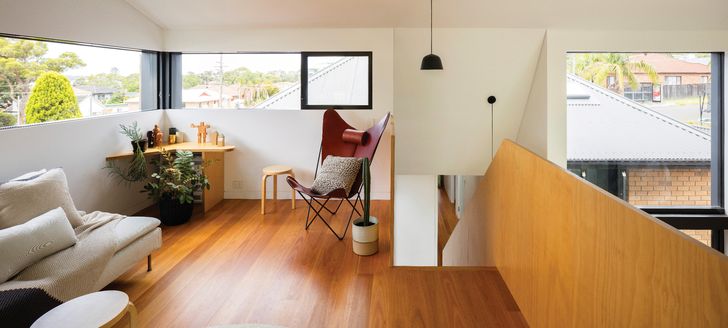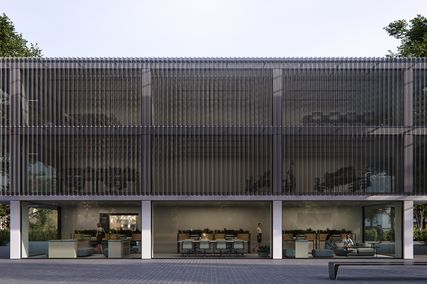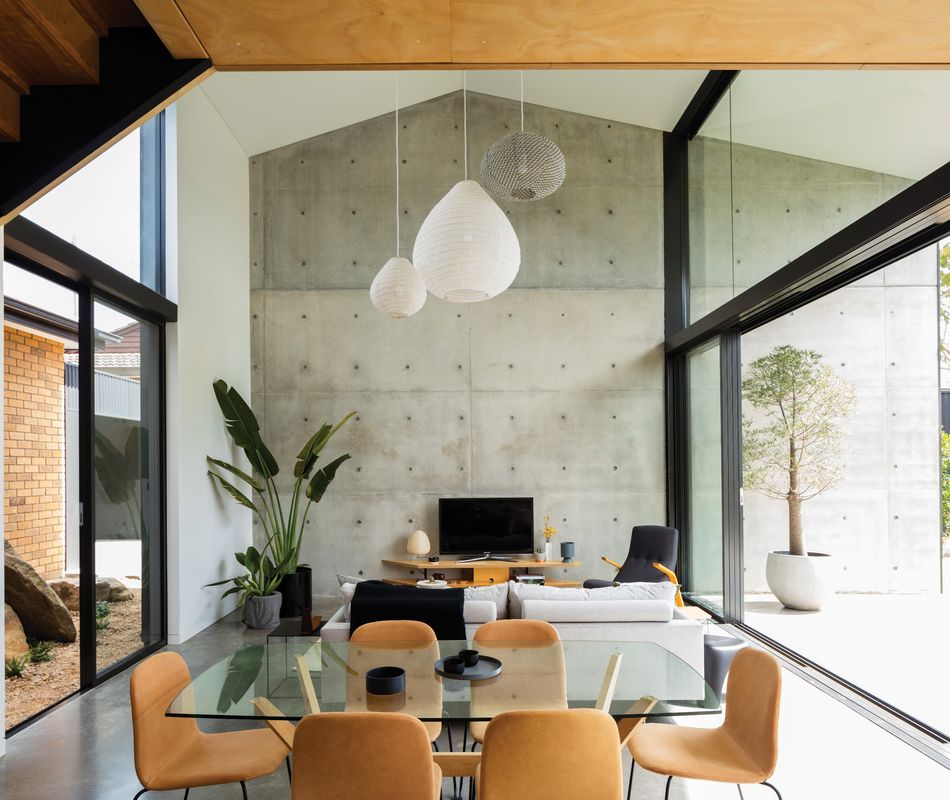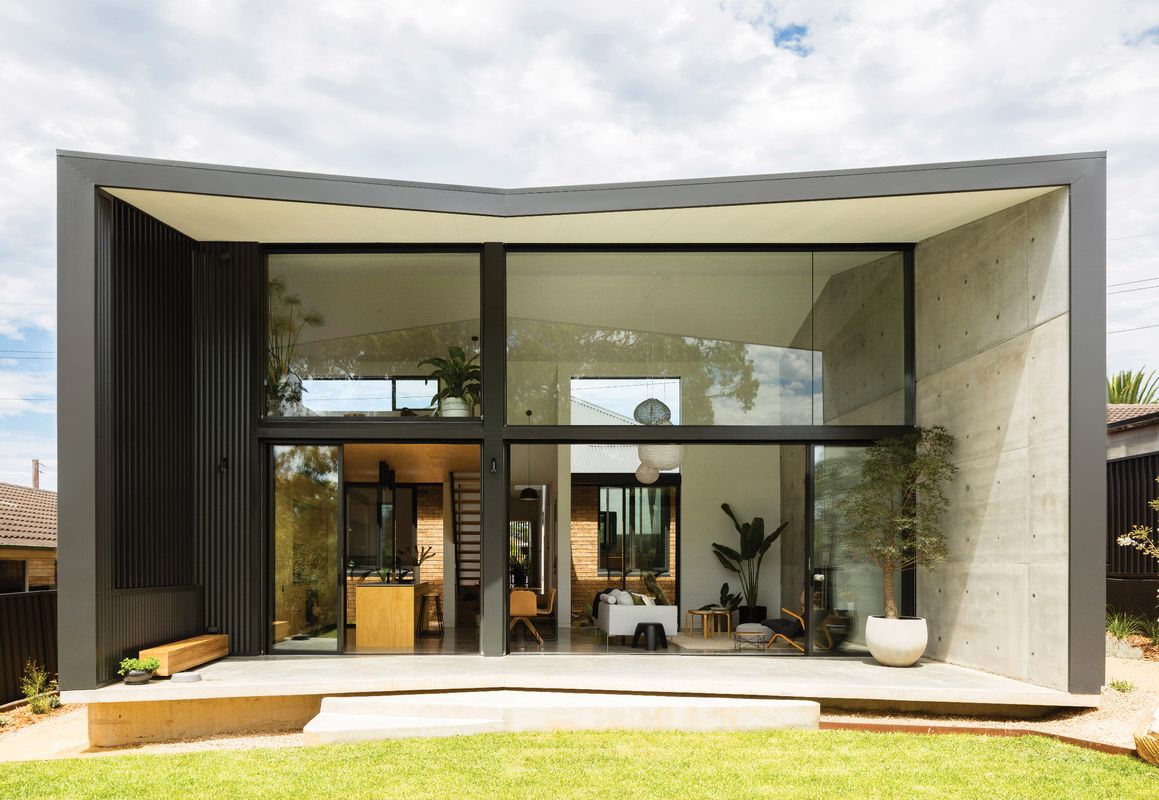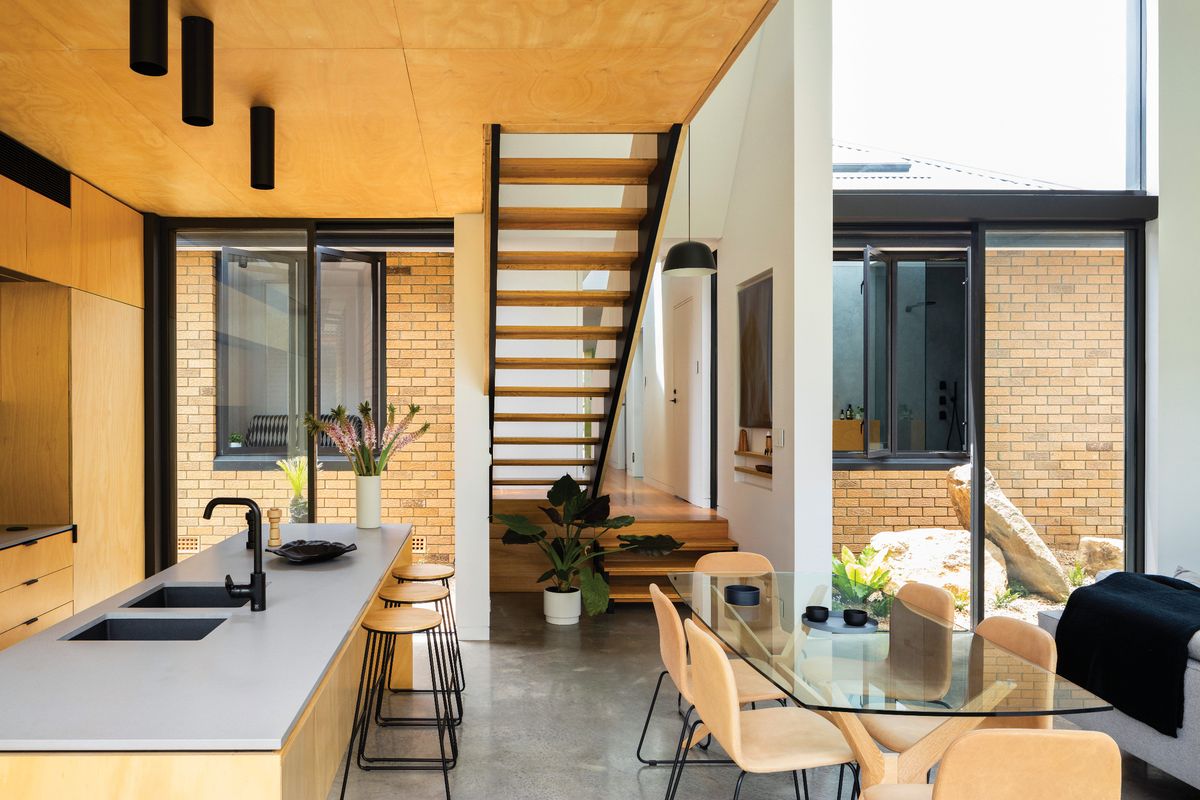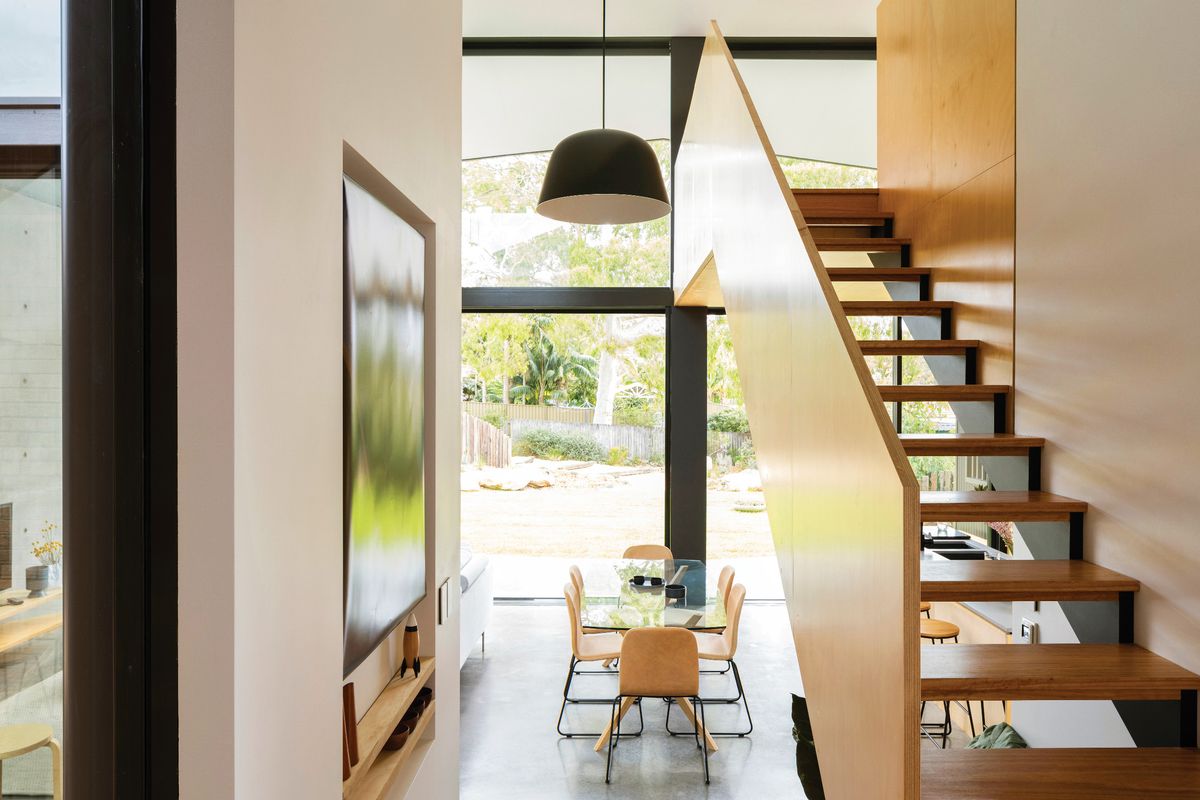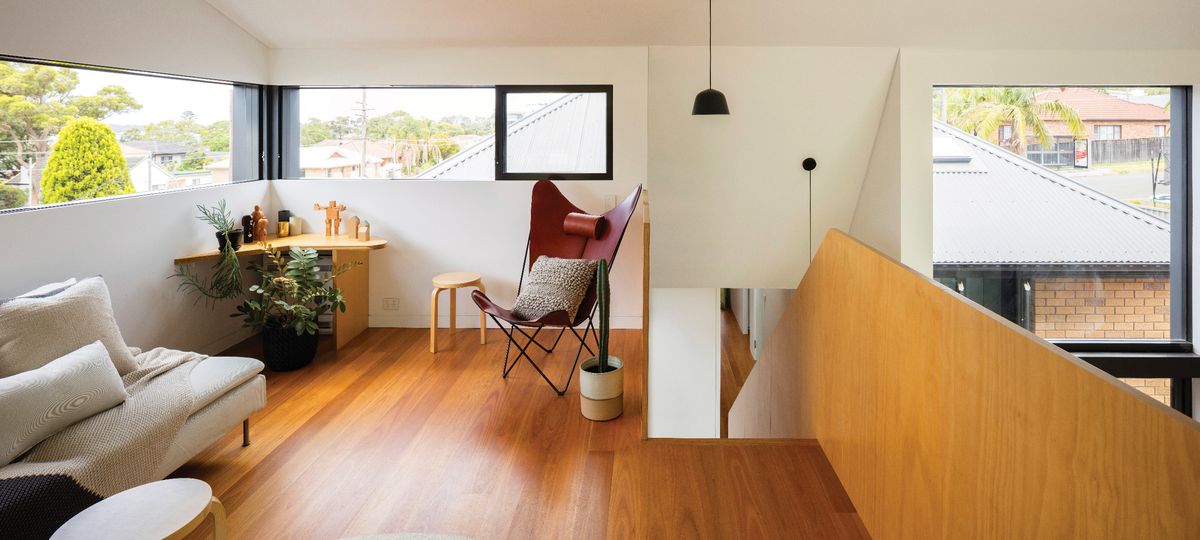Some fifty years since the publication of Robin Boyd’s The Australian Ugliness , architecture and suburbia still have an uneasy relationship. The Australian suburbs have traditionally been seen as the void between the architectural production of the inner city and the venerated bush house. Binary House by Christopher Polly Architect bridges this divide physically and conceptually in a radical re-take on the suburban brick bungalow.
The clients, who were from Melbourne, wanted the classic Sydney beach lifestyle without the hefty price tag. Eschewing the expensive eastern suburbs, they opted for a modest honey-coloured brick-veneer bungalow in Woolooware, twenty-four kilometres from the city. The home is located in the Sutherland Shire, a district that embraces both the beach and the bush. The clients commissioned Christopher Polly to transform the 1960 house into a modern residence that could accommodate their way of living and their boisterous dog, Ian.
The interior of the “voluminous, open and public” addition reaches as high as the entire roof of the front house.
Image: Brett Boardman
The extant three-bedroom house was in good condition and in its own manner formed part of a streetscape that was inherently and unapologetically suburban. Instead of seeing this as a negative, Christopher understood the importance of this characteristic and its value to the neighbourhood. It also made good sense economically and environmentally to keep as much of the existing fabric as possible. Apart from the realignment of a few interior walls, the golden-yellow brick cladding was kept, along with the original configuration of openings. Interior linings were updated and a new blackbutt floor installed. The warm yellow of the floor is paired with hoop pine cladding to the joinery units, the interior colour palette deliberately referencing the brick exterior. A skylight was introduced to break the potential gloominess of the central circulation corridor. The section of this skylight has been cut on an angle, giving it the drama of a large lantern. A curved bulkhead signals the end of the original house and the commencement of the new structure to the rear.
Expansive rear glazing opens up a dramatic vista across the native garden toward neighbouring eucalypts.
Image: Brett Boardman
The project is called Binary House because of the manner in which the two structures – existing house and garden pavilion – engage with each other. They are spatial opposites that are linked together. Whereas the front original house is one-storied, faces the street, is compartmentalized and contains the private and services spaces, the new addition faces the garden and is voluminous, open and public. They are linked visually and materially through what Christopher notes as the “binary play of gold and grey” – the old structure is gold coloured and the new structure is grey. The connection between these two structures is mediated by two interior courtyards, one on either side of the central corridor. The courtyards allow light, air and visual connection between the spaces while also bringing in borrowed views of the garden to the front house.
The interior of the garden pavilion reaches as high as the entire roof of the front house. An enormous vista toward the expansive native garden continues out to the neighbouring mature eucalypts. The interior southern wall of the pavilion is lined with a reinforced concrete wall, providing thermal mass to capture the warmth of the northern sun. This, together with the grey concrete floor, contrasts with the glimpses of the honey-coloured brick that you get when looking back toward the old house. The fact that looking at a 1960s yellow-brick wall could be pleasant and complement such refined contemporary architecture is a surprise, yet it works perfectly. Upstairs a flexible space, which is adaptable for use as a bedroom or study, enjoys views of the district and impressive sunsets. The clients really enjoy the afternoon and watching the sun set over the trees, so Christopher had to juggle this with the thermal performance issues of large expanses of glass. To allow for complete solar protection all the westerly and easterly glazing has roll-down blinds to the exterior. The western glazed wall is further protected from the sun by a deep, covered balcony that extrudes the form of the house outward. Toward the middle, the roof and floor are “pinched in” to get more northern light into the interior in winter. The extrusion also acts as a privacy device to protect from overlooking neighbours. The configuration of the garden pavilion, together with the two internal courtyards, effectively deals with privacy without compromising the openness of the home.
Taking advantage of the height of the addition, a flexible upstairs space offers views of the district and impressive sunsets.
Image: Brett Boardman
For Christopher, Binary House is a continuation of his exploration of the “spatial interplay between public and private.” This is achieved through a careful and thoughtful manipulation of the architectural and compositional elements without resorting to an empty formalism. Each plane, angle and kink has a specific purpose that relates to site, brief or function. Christopher admits that his clients were brave in choosing to undertake this project on this site. Yet the result is a clear example that good architecture can work well in a suburban context and is perhaps where it is most sorely needed.
Products and materials
- Roofing
- Lysaght Custom Orb in Colorbond ‘Monument’.
- External walls
- Lysaght Custom Orb in Colorbond ‘Monument’; timber-blade screen in Dulux ‘Monument’; recycled yellow bricks in Dulux ‘Monument’; steel-plate beams; in situ concrete.
- Internal walls
- Mister Ply and Wood hoop pine plywood in Cabots Cabothane Clear Satin sealer; in situ concrete; CSR Gyprock plasterboard and MDF in Dulux ‘White on White’.
- Windows
- Alspec aluminium sliding doors, pivot and fixed windows; AWS Magnum sliding windows; Centor insect screens; Velux skylights; Acmeda external retractable blinds.
- Doors
- Hume internal hinged doors in Dulux ‘White on White’.
- Flooring
- Abbey Timber blackbutt strip flooring; Armadillo & Co woven rugs in ‘Chalk’; burnished concrete slab.
- Lighting
- Paris Au Mois D’Aout Josephine pendants; Muuto Ambit pendants; ISM Objects Cans 100 ceiling lights; Xlux Pixel Mini LED downlights; Tovo Wedgie uplight; Bentu Qie pendants; Brilliant Lighting Denver II wall lights.
- Kitchen
- Fisher and Paykel integrated refrigerator; Westinghouse oven and induction cooktop; Delonghi rangehood; Bosch dishwasher; Blanco Subline sinks in anthracite; Mizu Soothe Square Gooseneck mixer in matt black; Caesarstone benchtops and splashback in ‘Sleek Concrete’; Mister Ply and Wood hoop pine joinery; Index and Co joinery pulls in matt black.
- Bathroom
- Everstone porcelain tiles from Academy Tiles; Rockcote Marrakesh acrylic render; Concrete Nation Lux basin; Cibo Fineline 4 basin (ensuite); Laufen Palomba toilets; Sterling freestanding oval bath; Phoenix Rush wall mixers and bath spout; Astra Walker Icon shower; Ausboard Inspire shower; Middle of Nowhere Flynn mirror; Vandiss Diabolo toilet roll holder.
- Heating and cooling
- Devi in-slab floor heating; Thermann gas-boosted evacuated tube solar hot water system; Daikin ducted airconditioning.
- External elements
- Burnished concrete terrace and sculpted steps; platforms, steps and retaining walls from recycled railroad sleepers; decomposed granite pathways; two 5,000-litre underground rainwater tanks.
- Other
- Seth leather dining chairs and Two-Back, three-seater sofa from Clickon; Knoll Grasshopper armchair; OX Denmarq KS chair; Eames wire-base table; Interwood Milano glass-top dining table; Artek Stool 60 stools; Milk and Sugar woven ottoman.
Credits
- Project
- Binary House
- Architect
- Christopher Polly Architect
Newtown, Sydney, NSW, Australia
- Project Team
- Christopher Polly
- Consultants
-
Builder
Owner
Engineer SDA Structures
Hydraulic engineer ACOR
Landscaping Fig Landscapes
- Site Details
-
Location
Sydney,
NSW,
Australia
Site type Suburban
Site area 786 m2
Building area 182 m2
- Project Details
-
Status
Built
Completion date 2018
Design, documentation 12 months
Construction 39 months
Category Residential
Type Alts and adds, New houses
Source
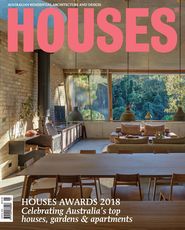
Project
Published online: 5 Nov 2018
Words:
Sing d'Arcy
Images:
Brett Boardman
Issue
Houses, August 2018

